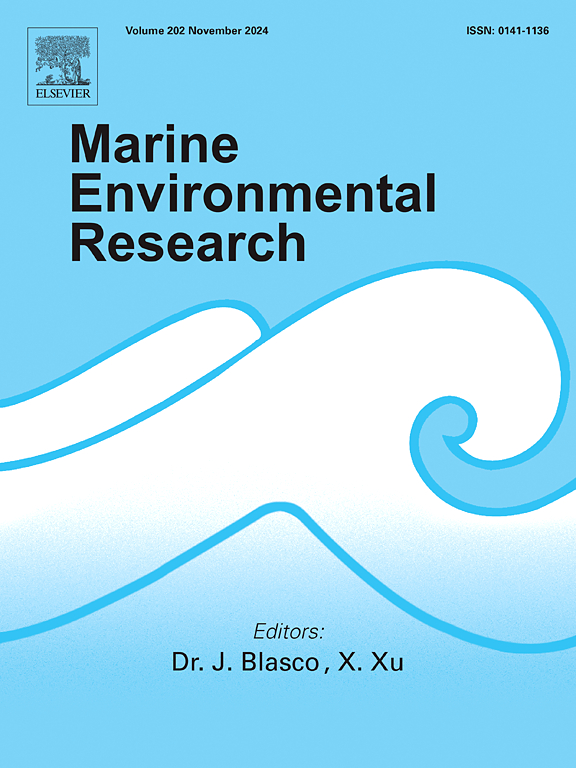对比巴西海岸两个河口系统的自然和人为历史变化:以底栖有孔虫为基础的古生态质量状况
IF 3.2
3区 环境科学与生态学
Q2 ENVIRONMENTAL SCIENCES
引用次数: 0
摘要
本研究采用多代理方法调查了巴西大西洋沿岸的两个河口生态系统及其历史变化。在上个世纪,Santos- sere o Vicente-Bertioga河口(Santos)受到了人为影响,如重工业和Santos港口的建设。Caravelas- nova viosa河口(Caravelas)保留了大部分原始状态,但在20世纪60年代左右新入口开放后,主要受到自然驱动变化的影响。我们使用沉积学、地球化学和底栖有孔虫指数来研究这两个河口历史上环境变化的不同驱动因素。利用生物多样性指数exp(H'bc)、生态质量比(EQR)、耐受性物种指数(TSI)和增强底栖有孔虫氧指数(EBFOI)来评价古生态质量状况(Paleo-EcoQS)。主成分分析(PCA)强调了系统对不同影响原因的响应,无论是人为的还是自然的。在桑托斯,主成分分析表明,沉积物组成、重金属富集和耐应力物种之间存在密切联系,反映了与工业和城市压力有关的古ecoqs的下降。卡拉维拉斯表现出对自然过程的动态响应,PCA得分与有机质输入和沉积物动态相关,表明尽管环境条件波动,但仍有恢复能力。这项工作显示了沉积记录在区分自然和人为影响方面的重要性,对于生物监测和保护策略具有重要的科学和社会意义。本文章由计算机程序翻译,如有差异,请以英文原文为准。
Contrasting natural and anthropic historical changes in two estuarine systems on the Brazilian coast: Benthic foraminiferal-based Paleo-Ecological Quality Status
This study uses a multiproxy approach to investigate two estuarine ecosystems located along the Brazilian Atlantic coast and their historical changes. In the last century, the Santos-São Vicente-Bertioga Estuary (Santos) has been subjected to anthropogenic influences such as heavy industrialization and the construction of the Santos Port. The Caravelas-Nova Viçosa Estuary (Caravelas) has preserved most of its pristine condition but has been mainly affected by naturally driven changes after the opening of a new inlet around the 1960s. We use sedimentological, geochemical, and benthic foraminiferal indices to investigate the distinct drivers of environmental changes throughout the history of these two estuaries. Different biotic indices were tested to assess the Paleo-Ecological Quality Status (Paleo-EcoQS): the diversity index exp(H'bc), the Ecological Quality Ratio (EQR) computed based on local reference conditions, the Tolerant Species Index (TSI) and the Enhanced Benthic Foraminifera Oxygen Index (EBFOI). The Principal Component Analysis (PCA) highlights the systems' responses to different causes of impact, either anthropogenic or natural. In Santos, the PCA indicates a strong association between sediment composition, heavy metal enrichment, and the prevalence of stress-tolerant species, reflecting a decline in the Paleo-EcoQS linked to industrial and urban pressures. Caravelas exhibits a dynamic response to natural processes, with positive PCA scores correlated with organic matter inputs and sediment dynamics, suggesting resilience despite fluctuating environmental conditions. This work shows the importance of sedimentary records in distinguishing between natural and human-induced impacts, having great scientific and social relevance both for biomonitoring and informing conservation strategies.
求助全文
通过发布文献求助,成功后即可免费获取论文全文。
去求助
来源期刊

Marine environmental research
环境科学-毒理学
CiteScore
5.90
自引率
3.00%
发文量
217
审稿时长
46 days
期刊介绍:
Marine Environmental Research publishes original research papers on chemical, physical, and biological interactions in the oceans and coastal waters. The journal serves as a forum for new information on biology, chemistry, and toxicology and syntheses that advance understanding of marine environmental processes.
Submission of multidisciplinary studies is encouraged. Studies that utilize experimental approaches to clarify the roles of anthropogenic and natural causes of changes in marine ecosystems are especially welcome, as are those studies that represent new developments of a theoretical or conceptual aspect of marine science. All papers published in this journal are reviewed by qualified peers prior to acceptance and publication. Examples of topics considered to be appropriate for the journal include, but are not limited to, the following:
– The extent, persistence, and consequences of change and the recovery from such change in natural marine systems
– The biochemical, physiological, and ecological consequences of contaminants to marine organisms and ecosystems
– The biogeochemistry of naturally occurring and anthropogenic substances
– Models that describe and predict the above processes
– Monitoring studies, to the extent that their results provide new information on functional processes
– Methodological papers describing improved quantitative techniques for the marine sciences.
 求助内容:
求助内容: 应助结果提醒方式:
应助结果提醒方式:


